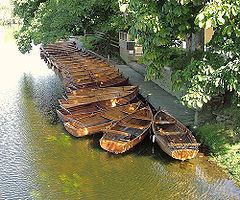Population 1,907 (2011) Sovereign state United Kingdom | OS grid reference TM057331 Post town COLCHESTER Local time Sunday 11:15 AM Dialling code 01206 | |
 | ||
Weather 5°C, Wind S at 34 km/h, 92% Humidity | ||
Malt house crown rise dedham essex
Dedham is a village within the borough of Colchester in northeast Essex, England, on the River Stour and the border of Essex and Suffolk. The nearest town to Dedham is the small market town of Manningtree.
Contents
- Malt house crown rise dedham essex
- Map of Dedham Colchester UK
- Gopro kayak canoeing trip river stour dedham essex
- Governance
- Geography
- Dedham Classis
- Dedham Settlers in the Massachusetts Bay Colony
- John Constable
- Other artists
- Architecture
- Economy
- Local amenities
- Transport
- Notable people
- References
Map of Dedham, Colchester, UK
Gopro kayak canoeing trip river stour dedham essex
Governance
Dedham is part of the electoral ward called Dedham and Langham. The population of this ward at the 2011 Census was 2,943.
Geography
Dedham is frequently rated as containing some of England's most beautiful Lowland landscape, most particularly the water meadows of the River Stour, which passes along the northern boundary of the village forming the boundary between Essex and Suffolk. Dedham has a central nuclear settlement around the Church and the junction of Mill Lane and the High Street (part of the B1029). Connected to Dedham are the hamlets of The Heath and Lamb Corner. The village forms a key part of the Dedham Vale.
Dedham Classis
In 1582–1587, a schismatic Presbyterian Christian group called the Dedham Classis, which included dozens of members opposed to the established church, was active in north-east Essex. This group held clandestine meetings and prayer groups in and around Colchester and surrounding villages like Dedham, publishing and distributing versions of Wycliffe's Bible and various other Calvinist texts obtained from London; the Dedham Classis is the best recorded of those active in the sixteenth century.
Dedham Settlers in the Massachusetts Bay Colony
A group of early dissenters left Dedham to found the township of Dedham in the Massachusetts Bay Colony in 1635. Under the leadership of John Rogers, a preacher banned from his work in England, they established a settlement on the western edge of the colony first established in 1628, now a suburb of the city of Boston. Despite some early setbacks this township eventually proved very successful and a number of prominent US families can trace their ancestry from these early arrivals from East Anglia – see note below on William Tecumseh Sherman.
John Constable
Dedham is at the heart of 'Constable Country' – the area of England where Constable lived and painted. Constable attended the town's Grammar School (now the 'Old Grammar School' and 'Well House'), and he would walk to school each morning alongside the River Stour from his family's home in East Bergholt. Many of Constable's paintings feature Dedham, including Dedham Mill, which his father owned, and Dedham Parish Church, whose massive Caen stone and flint tower is a focal point of the surrounding Dedham Vale.
Other artists
In 1937, Cedric Morris and Arthur Lett-Haines founded the East Anglian School of Painting and Drawing at Dedham. When, however, this burnt down, they moved to Hadleigh, Suffolk.
Of longer influence in Dedham was the horse painter Sir Alfred Munnings, who became President of the Royal Academy. His house in Dedham, Castle House, now contains a gallery of his work, and his studio.
Tom Keating, the art restorer and famous art forger, was a Dedham resident until his death in 1984. He is buried in the churchyard of Dedham Parish Church.
Architecture
Dedham contains a number of well-preserved buildings:
Economy
Formerly a rich wool town and market town, Dedham is a flourishing commercial village, with a post office, butcher, Co-op, grocer, delicatessen, art shop and various other shops. Agriculture is also important with mainly arable land (sugar beet and wheat) but also cattle grazing on the water meadows and some sheep on Grove Hill. There is an industrial estate near the A12 road, a main route passing the west of the village. A business centre and nursing home have recently opened.
Local amenities
Transport
Manningtree can easily be accessed by bicycle or by walking along the banks of the River Stour. Manningtree railway station provides regular, fast commuter services to London and Norwich. Colchester can be reached by bus. School buses service all the schools in Colchester and the independent schools in Ipswich.
